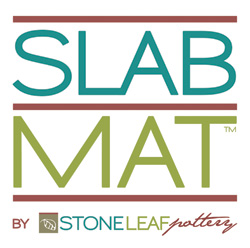Tips
Here are tips to help you enjoy SlabMat that much more.
When cutting clay directly on SlabMat, a wooden or dull metal fettling knife is recommended. Use care to limit the sharpness of the cutting tool and the pressure applied while cutting to avoid permanent damage to the mat.
For the smoothest slabs, use a SlabMat on both sides of the clay slab, with the smooth side of SlabMat touching the clay.
One long piece of SlabMat may be used for small clay slabs, folded over itself with the clay sandwiched in between. If the mat becomes creased, the crease will be permanent.
SlabMat can be used in conjunction with other materials, like heavy weight paper or fabric, to add defined texture to one side of a clay slab, while keeping the opposite side totally smooth.
If you encounter problems with SlabMat slipping on a slick surface, a piece of rubber shelf liner can be used underneath for added grip.
If your clay is clay is sticking to SlabMat, your clay may be too moist. This can be easily remedied with a light dusting of cornstarch on the mat. Cornstarch reduces sticking and will burn off in the firing.
Do not store your clay on SlabMat after use.
Unlike canvas, the SlabMat can be used to roll multiple slabs in one studio session before becoming too saturated and causing clay to stick.
Prolonged wetness may cause the SlabMat to become wavy, but it can be dried between two pieces of sheetrock (drywall) to re-flatten.
SlabMat will absorb stains from your colored clays. We recommend a set of mats for each color or type of clay used in your studio (white, red, porcelain, etc.)
If you can roll your clay on canvas, you can roll your clay on SlabMat!
